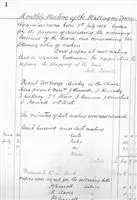While the present system of local government dates largely from a parliamentary act of 1898, there were some earlier local authorities with long histories. Fortunately, a substantial quantity of their archives has survived in the county. Those predecessor bodies in Westmeath include:
Info! :In order to consult any of this material you must first contact the Archives Department in Library Headquarters, Tel: 044-9332162
Grand Juries were established by the Anglo-Normans and, originally, were involved only in the administration of justice. The high sheriff in a county called twenty-three landowners together twice annually to consider cases and refer them to court for trial. In the seventeenth century, their remit was widened to include projects such as the building and repair of roads, bridges, courthouses and gaols. A tax known as cess was raised to fund the works.
With the establishment of County Councils in 1899, the Grand Juries lost their functions in relation to infrastructure, but retained their judicial role until their abolition in 1924. In the mid-eighteenth century, the practice of holding presentment sessions began. Someone applying for work such as road-repairs to be done would present a certificate to the Grand Jury, signed by a justice of the peace, stating that the work was necessary and estimating the cost.
The ‘poor law’ was extended to Ireland in 1838, with the division of the country into poor law unions, each served by a workhouse. A board of guardians administered the workhouse and it consisted of two types of member: those elected by ratepayers and those who were ex-officio. The board set a rate each year for each electoral division that reflected the numbers of inmates in the workhouse from that division. Later, the boards were given some sanitary functions including responsibility for sewerage schemes and slaughterhouses.
In the early 1920s, the workhouses were replaced by county homes under amalgamation schemes. The minute books of the board meetings provide statistics on the number of inmates at the time of each meeting, and detail the matters discussed and decisions reached. Westmeath had two workhouses – Mullingar and Athlone. The surviving minute books are as follows:
Also from Mullingar Union: - daily diet book, 1857-1858; - porter’s books, 1858-1859; 1868-1869; - diet class book, 1862-1863; - clothing receipt book, 1863-1866 (microfilm); - cream account book, 1867-1868 (microfilm); - weekly relief list and abstract for half year ending 25 March 1879.
Some of the later financial records of both unions survive, but are currently unavailable to researchers because they have not been processed.
The creation of boroughs began with the Anglo-Normans. A borough received a charter from the monarch and had a corporation that exercised administrative and judicial functions: it passed bye-laws, collected revenues, including toll and customs, and the held a civil court. A borough was also entitled to hold markets and fairs.
With the establishment of County Councils in 1899, the Grand Juries lost their functions in relation to infrastructure, but retained their judicial role until their abolition in 1924. Athlone received its first charter in 1599, and others in 1606 and 1687. The corporation consisted of a sovereign, twelve burgesses and an unlimited number of freemen. A common council, consisting of the burgesses and freemen chosen to serve for life, exercised the corporation’s authority. The borough returned two members of parliament until the Act of Union (1800) when it lost one. It was abolished by the Municipal Corporations (Ireland) Act of 1840. Later, a Town Commission was created. The only surviving item from the archives of Athlone Corporation is: a common council book: 24 June 1804–10 October 1816.

The Lighting of Towns ( Ireland ) Act of 1828, established Town Commissions with responsibility for lighting and cleaning. The Towns Improvement Act (1854) gave them more powers in the sanitary area
Mullingar Town Commission was created in 1856, in response to the second act. As the century progressed, the commission became responsible for burial grounds, sewerage and (from 1890) urban housing. The minute books of Mullingar Town Commission are available as follows: 7 July 1908–4 April 1957.
Financial records of the commission are unavailable until fully processed.